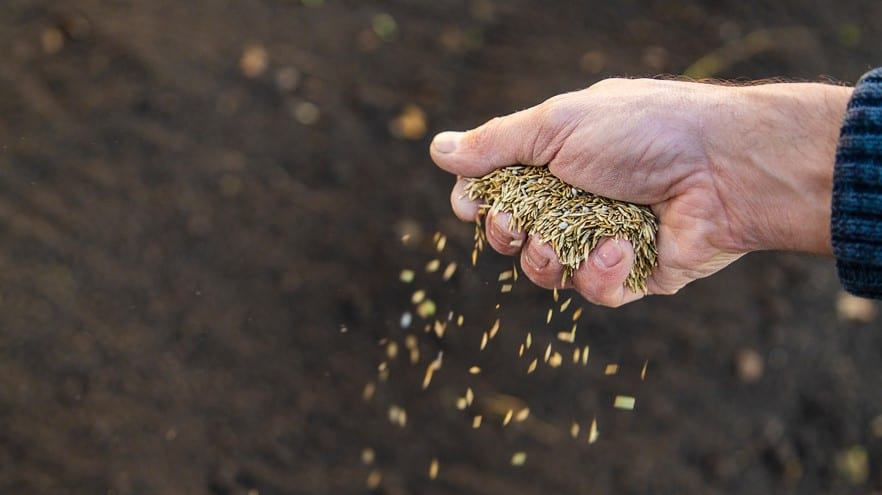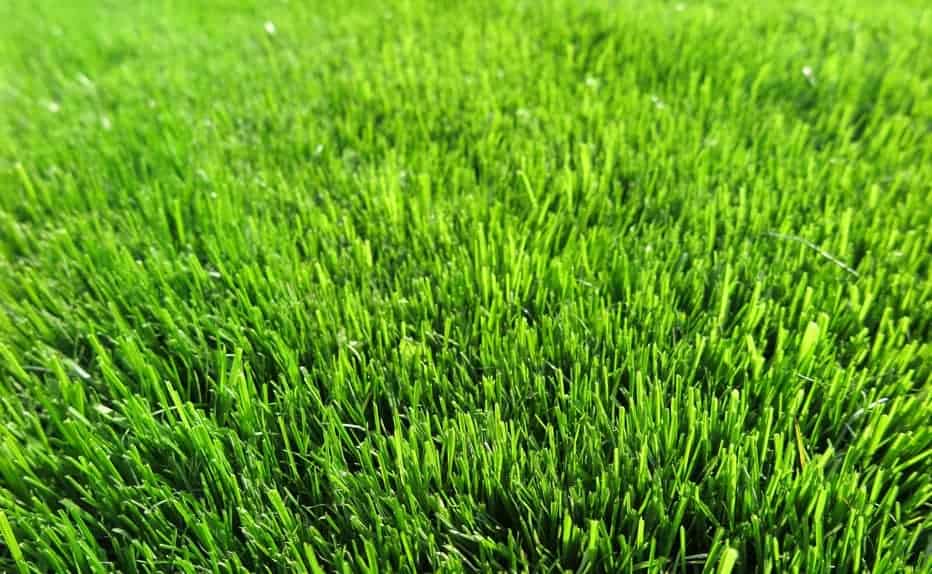Have you ever wondered why your lawn looks patchy and worn out? Well, you’re not alone. As someone who takes pride in my lawn and enjoys spending much time in my yard, I understand your frustration.
I’ve tried a lot of different products and methods, but I have to say that overseeding has been one of the most effective solutions for me.
The most important thing to mention is that it will improve the quality of your lawn, making it luscious and healthy. However, many people struggle to determine when it’s safe to mow new grass. Fasten your seatbelts and get ready to find the best answer!
Contents
- 1 So How Soon Can You Cut the Grass After Overseeding?
- 2 Getting Started
- 3 Choose Your Preferred Lawn Type
- 4 Spreading Seeds
- 5 Lawn-Care For Newly Overseeded Lawns
- 6 How Long Should You Wait Before Mowing Your Lawn After Overseeding?
- 7 Mowing Your Lawn After Overseeding
- 8 Overseeding After-Care
- 9 Achieving Lawn Perfection: Extra Mowing Tips
- 10 FAQs
- 11 Now You Know When To Mow Your New Grass After Overseeding
- 12 About The Author
So How Soon Can You Cut the Grass After Overseeding?
Overseeding is a simple process that involves planting new grass seeds to fill in bare spots and thicken the lawn. And let me tell you, it really works. I’ve seen a noticeable improvement in the appearance and health of my lawn since I started overseeding.
But as with any lawn care method, timing is key. From my own experience, I can say that it’s best to leave new grass untouched after the planting process for at least two to three weeks. This will allow the new, fragile roots to settle before getting disturbed through the process of mowing; giving the new seedlings a chance to rest is key to successful overseeding.
I’ve made the mistake of mowing too soon after overseeding in the past, and it wasn’t a good idea. The fragile roots easily get disturbed, and the new grass seedlings can be uprooted or damaged, undoing all the hard work you’ve put in. So trust me when I say that giving the new seedlings time to rest is key to successful overseeding.
I’ve put together this handy guide to help you understand the importance of timing when it comes to mowing overseeded lawns, as well as the ins and outs of the whole process.

Getting Started
I’ve been overseeding my lawn for a while now, and I’ve found that proper preparation is key to ensuring the success of the process.
One step that I always take before overseeding is mowing the lawn a little shorter than usual. Next, I recommend removing your grass clippings and raking the top layer of soil. This will ensure that the soil is loose and has sufficient exposure to sunlight. It will also help you avoid any remaining dead grass, creating a healthy environment for germination.
Another technique that I’ve found incredibly helpful is aerating my lawn. I know it might sound like a lot of work, but trust me when I say that it’s a no-lose way to prepare your lawn for overseeding.
The process of aeration allows oxygen, water, and nutrients to infiltrate deep into the soil and the root zone. This will enhance the root-development environment, thus encouraging the growth of a stronger grassroots.
I stumbled upon a great video on YouTube where user DirtFarmerJay discusses the details of aerating your lawn. Watching the video helped me understand the process better and gave me some tips on how to do it more efficiently. I highly recommend checking it out if you’re considering overseeding your lawn.
Choose Your Preferred Lawn Type
Choose the type of grass you’d like to grow. It’s vital to consider which types of grass are compatible with the climate of your region, as well as the quality of the seed you’ll be using.
I have friends who live in Florida and they overseeded their lawn with some of the best grass types to grow, Zenith Zoysia and St. Augustine “Palmetto,” and I can confidently say that they are great choices for the Florida climate.
Spreading Seeds

During my overseeding experience, I’ve also found that following the instructions on the seed packaging is crucial for success. The label will typically provide detailed instructions on how to properly distribute the seeds for the best results.
So follow the overseeding instructions as per the label on your seed packaging when distributing them. A lawn spreader simplifies the process, but if you’re overseeding a small section, you can spread the seeds by hand.
Also, avoid overseeding during windy conditions. Wind can cause the seeds to spread unevenly, resulting in patchy growth. So, if the wind is gusty, it’s best to wait until the conditions are calmer before you start overseeding.
Lawn-Care For Newly Overseeded Lawns
When I first overseeded my lawn, I had no idea that watering was such an essential aspect of lawn care. After a few days, I noticed that the seeds didn’t germinate, and my lawn was looking patchier than ever.
That’s when I realized that watering is critical for newly overseeded lawns, and I started watering the area twice a day, making sure the soil was always moist. And it worked! I started seeing the new grass sprouting within a week or so.
I also made the mistake of applying fertilizer too soon after overseeding my lawn, which resulted in the old grass growing at an accelerated rate, choking out the new grass. It’s crucial to avoid this mistake and wait for the new roots to develop, which typically takes around two to three weeks. Then, you can use fertilizer to promote the healthy growth of your lawn.
As for distributing the seeds, I found that using a lawn spreader made the process much more manageable, but for small areas, you can always spread the seeds by hand. However, it’s essential to avoid overseeding during windy conditions, as this can result in an uneven spread of the seeds.
In this video, YouTube user HortTube with Jim Putnam discusses when you should ideally use fertilizer if you’re thinking about overseeing:
How Long Should You Wait Before Mowing Your Lawn After Overseeding?
People frequently ask, ‘How long should I wait to mow after overseeding?’ As someone who has become an expert in overseeding, I can attest to the importance of waiting before mowing. Ideally, you should hold off on mowing your lawn for at least two to three weeks after the planting process. This will give your new, fragile grassroots a chance to settle.
Mowing before your roots settle may exert pressure on your new roots. Timing is crucial in our business, and patience is key.
The answer to this question, though, is not one hundred percent straightforward. It all depends on the type of grass you grow and the height of regrowth. This will differ across locations and climates.
If you’re unsure about when to mow your newly overseeded lawn, there are plenty of helpful resources available online. I personally found the video from Ryan Knorr Lawn Care to be quite informative and useful in answering this question.
Mowing Your Lawn After Overseeding
When it comes to mowing your lawn after overseeding, it’s crucial to be careful and avoid damaging the newly developing roots. In my experience, I found it best to refrain from mowing your lawn less than three inches high.
After putting in all that hard work to overseed your lawn, you’ll want to be careful not to disturb the new, forming roots. Make sure your soil isn’t wet when mowing, as lawnmowers can damage the grass blades.
YouTube user Grass Daddy shares footage of his first time mowing new grass after overseeding in this video, which I found incredibly useful:
Overseeding After-Care
For your overseeding efforts to be successful, you will need to adopt different garden-care practices, as overseeded lawns are rather sensitive.
I learned this the hard way when I accidentally drove my car over my newly overseeded lawn, causing significant damage to the grass. It took several weeks of careful nurturing and extra watering to recover from the mishap.
To avoid any similar accidents, it’s a good idea to mark off the area with stakes or flags to remind yourself and others to stay off the lawn. With proper care and attention, your newly overseeded lawn will soon flourish into a lush and healthy green carpet.
Achieving Lawn Perfection: Extra Mowing Tips

Here are some extra tips from me which will help you unleash the full potential of your lawn after overseeding:
- Take it slow. When you’re mowing your newly overseeded lawn, it’s essential to do it at a slow pace. This means mowing at a slower speed than you would for an established lawn. Mowing too quickly can cause damage to the new grass blades, stunting growth and creating bald patches.
- Keep your mower blade sharp. A dull mower blade can tear the grass, which can make it more susceptible to disease and insect infestations. Be sure to sharpen your mower blade regularly to prevent this from happening.
- Don’t bag the clippings. When mowing a newly overseeded lawn, it’s best to leave the clippings on the lawn. Clippings act as a natural fertilizer, helping to nourish the new grass as it grows. If you decide to bag the clippings, compost them and use them as a natural fertilizer for your lawn.
- Change mowing directions. Don’t want your lawn to look uneven? Then change the moving direction each time you mow.
- Don’t remove too much grass. Whenever you mow after overseeding, avoid removing more than one-third of the grass blade at a time. Removing too much grass can stress the new seedlings and hinder their growth.
FAQs
How long should you wait to cut new grass?
You should wait to cut new grass for at least two to three weeks after overseeding your grass before mowing. This will give new roots sufficient time to spread and develop.
When to cut grass after overseeding?
You can cut your grass after overseeding once it has reached a mowing height of at least three inches. This should take approximately two to three weeks after overseeding.
What is the best time of day to mow new grass?
It’s best to mow your new grass in the early morning or late afternoon when the weather is cooler, and the grass is less stressed. Avoid mowing in the midday heat when the sun is at its strongest.
Does cutting new grass help it grow?
Cutting new grass does help it grow. It encourages little tufts to spread and grow evenly over a shorter period of time.
Now You Know When To Mow Your New Grass After Overseeding
Maintaining a lush and healthy lawn is every homeowner’s dream. Overseeding is an excellent way to achieve this, but it’s crucial to know when to mow new grass to avoid damaging your lawn.
Ideally, it’s best to wait until your new grass is at least three inches tall before mowing. It’s important to note that the waiting period may differ depending on the type of grass you’ve planted and the weather in your area. In my experience, I waited about four weeks before mowing my new grass to give it the best chance to thrive.
By waiting for the right time to mow, you’ll encourage strong root growth, and your lawn will be ready for its first trim.
So, how long after overseeding can you mow? Just be patient and allow your new grass to grow for a few weeks before breaking out the lawnmower. With proper care and maintenance, your newly overseeded lawn will flourish and become the envy of the whole neighborhood!
Please feel free to comment with your overseeding experiences and questions!




